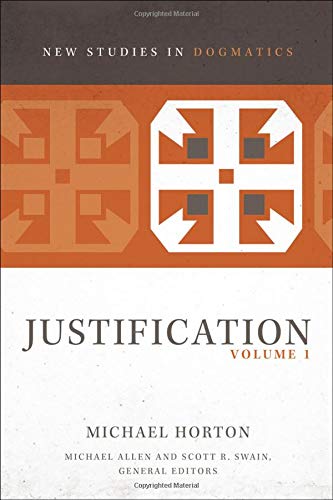A Brief Book Summary from Books at a Glance
By Mark Baker
About the Author
Michael Horton (PhD, University of Coventry and Wycliffe Hall, Oxford) is J. Gresham Machen Professor of Systematic Theology and Apologetics at Westminster Seminary California. He has authored many books including The Christian Faith: A Systematic Theology for Pilgrims on the Way. He also hosts the White Horse Inn radio program (back cover).
Overview of the Series
Michael Allen and Scott R. Swain serve as co-editors of the New Studies in Dogmatics series. The series “follows in the tradition of G.C. Berkouwer’s classic series, Studies in Dogmatics, in seeking to offer concise, focused treatments of major topics in dogmatic theology that fill the gap between introductory theological textbooks and advanced theological monographs” (11). It further seeks to engage in constructive theology through the process of renewal through retrieval. Retrieval “is an inclusive and enlarging venture, a matter of tapping to a vital root and, in some cases, of relearning a lost grammar of theological discourse, all for the sake of equipping the church in its contemporary vocation to think and speak faithfully and fruitfully about God and God’s works” (12). Each book in this series aims to do four things: (1) to engage with the “state of the question” of the particular topic; (2) to interact with biblical-theological and exegetical patterns that form the particular doctrine; (3) to give attention to ecclesiastical statements of the church and leading theologians; (4) to locate the doctrine within the larger system of theology as well as in practical application.
Overview of the Book
This two-volume series seeks to retrieve the doctrine of justification by specifically locating sanctification in the context of other doctrines of the Christian faith. Volume 1 is a descriptive exercise in historical theology and specifically engages with the doctrine of justification from the patristic era through the Reformation.
Table of Contents
- The Right Time to (Re)consider Justification
- “O Sweet Exchange!”: A Broader Lens for Discovering the Patristic Consensus
- Justification and the Ancient Church
- Justification, Penance, and the Metaphysics of Grace: Lombard and Aquinas
- “Do What You Can”: Scotus and the Rise of Nominalism
- The Road from Penance to Christ
- The Reformers and the Great Exchange: Mystical Union
- Reforming Justification
- A New Direction: Word, Faith, and Works
- Law and Gospel: A Tale of Two Covenants
- The Triumph of Nominalism
- Justification and the Christian Life
Book Summary
Chapter 1: The Right Time to (Re)consider Justification
Luther’s question is now famous: “How can I find a gracious God?” But many people want to leave Luther’s question in the past. Times have changed, they say: Justification is less about easing an overly introspective conscience and more about the covenant community or more about liberation from darkness. Yet these new suggestions are merely a product of our own time. “Say whatever you like about the Protestant Reformers, but they were not obsessed with introspection” (23).
The Roman Catholic Church currently defines justification as “not only the remission of sins, but also the sanctification of the interior man” (24). This definition openly connects justification and sanctification in a strong way: a believer’s final justification depends on the merits that a believer performs. In view of this definition, Luther’s critique is still valid. Justification and sanctification are inseparable yet distinct. These “distinct acts must never be confused or separated” (25).
There have also been several new movements that have sought to redefine justification. The New Perspective on Paul, advocated by scholars such as E. P. Sanders and N. T. Wright, has redefined justification to focus on who is “in” the covenant and who is “out.” It also focuses more on ecclesiology (covenant community) rather than soteriology (salvation). The New Finnish Interpretation of Luther has reexamined Luther’s theology and claimed that Luther was quite close to the Eastern Orthodox idea of theosis or deification. Both of these movements deny the imputation of Christ’s righteousness in justification, and both views are gravely mistaken in some of their points. This book hopes “at least to challenge binaries and false choices both in historical descriptions of the Reformation’s views and in exegetical and doctrinal conclusions” (38).
Chapter 2: “O Sweet Exchange!”: A Broader Lens for Discovering the Patristic Consensus
The concept of the “great exchange” is first found in the late first- or early second-century Epistle to Diognetus: “O sweet exchange… that the sinfulness of many should be hidden in one righteous person, while the righteousness of one should justify many sinners!” (39). This concept is another way of referring to union with Christ, and this theme will serve as an organizing principle for much of this book. Here are three reasons why: first, the great exchange allows for many other images to describe justification, such as the washing of garments, economic language, agricultural language, architectural images, and marriage. Second, “the great exchange helps us to take our starting point not from church-dividing differences over justification itself but from the consensus teaching in the ancient church” (40–41). Third, it helps connect justification with other aspects of salvation such as election, redemption, and adoption.
[To continue reading this summary, please see below....]The remainder of this article is premium content. Become a member to continue reading.
Already have an account? Sign In
